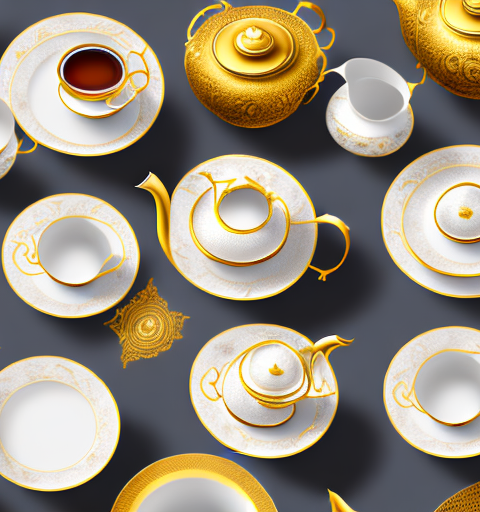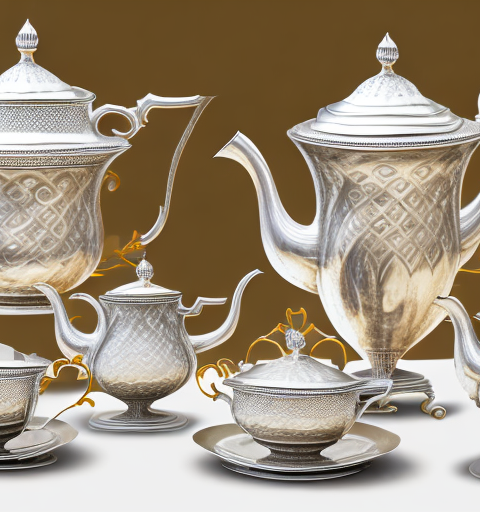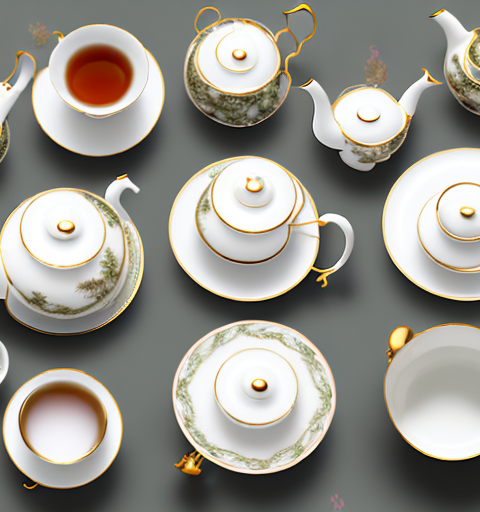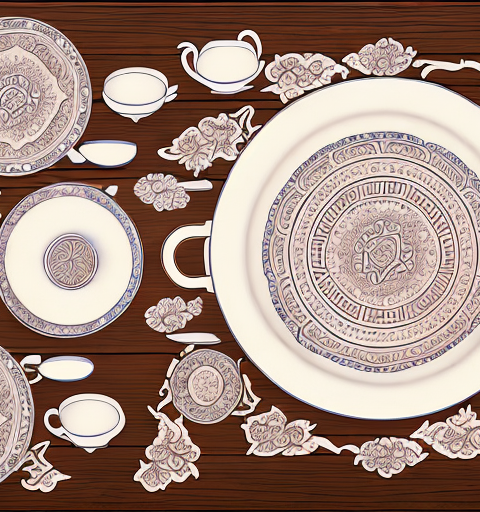Ceramic teapots are not only functional but also beautiful pieces of art that require proper care to maintain their beauty and functionality. One crucial step in taking care of your ceramic teapot is ensuring it is thoroughly dried after cleaning. In this article, we will explore the importance of proper drying techniques for ceramic teapots and provide you with a step-by-step guide on how to effectively dry your teapot. We will also discuss the different methods of drying, including air-drying and towel-drying, and weigh their advantages and disadvantages.
Understanding the importance of proper drying for ceramic teapots
Properly drying your ceramic teapot is essential to prevent the growth of mold and mildew that can damage both its appearance and functionality. When moisture is left inside the teapot, it creates a breeding ground for bacteria, which can lead to unpleasant odors and potential health risks. Additionally, prolonged exposure to moisture can cause the teapot to develop cracks or other structural damage. Therefore, it is crucial to employ effective drying techniques to ensure proper maintenance of your teapot.
One effective drying technique for ceramic teapots is air drying. After washing the teapot, gently pat it dry with a clean towel to remove excess moisture. Then, place the teapot in a well-ventilated area, away from direct sunlight, and allow it to air dry completely. This method allows the teapot to dry naturally, reducing the risk of moisture buildup and potential damage.
Another option is to use a drying rack specifically designed for teapots. These racks typically have multiple levels or hooks to hang the teapot upside down, allowing any remaining water to drip out. This method ensures thorough drying and helps prevent water from pooling inside the teapot, which can lead to mold or mildew growth.
Step-by-step guide to effectively drying your ceramic teapot
When it comes to drying a ceramic teapot, a systematic approach will ensure the best results. Here is a step-by-step guide to help you effectively dry your teapot:
- After cleaning your teapot with a gentle detergent, rinse it thoroughly with warm water to remove all traces of soap.
- Gently shake the teapot to remove excess water from the inside.
- Place the teapot upside down on a clean towel to allow any remaining water to drain out.
- Using a soft, absorbent cloth, pat the exterior of the teapot to remove any surface moisture.
- Inspect the spout, handle, and lid for any hidden pockets of moisture, and dry them with a cloth or a cotton swab.
- Leave the teapot in a well-ventilated area to air-dry completely before storing or using it again.
It is important to note that ceramic teapots should never be dried using heat sources such as ovens or hair dryers. The sudden change in temperature can cause the teapot to crack or break. It is best to allow the teapot to air-dry naturally.
If you notice any stubborn stains or residue on your teapot after it has dried, you can try using a mixture of baking soda and water to gently scrub the affected areas. Be sure to rinse the teapot thoroughly afterwards to remove any traces of the baking soda mixture.
The different methods of drying ceramic teapots after cleaning
There are two primary methods of drying ceramic teapots: air-drying and towel-drying. Both methods have their advantages and disadvantages.
Air-drying is the most common method of drying ceramic teapots. After cleaning, simply place the teapot in a well-ventilated area and allow it to dry naturally. This method is convenient and requires minimal effort. However, it can take a longer time for the teapot to completely dry, especially in humid environments.
Air-drying vs. towel-drying: Which method is better for your ceramic teapot?
Air-drying is the most natural and gentle method for drying ceramic teapots. By allowing the teapot to dry on its own, you minimize the risk of causing any accidental damage. However, air-drying can be a time-consuming process, especially if you are in a hurry to reuse your teapot. On the other hand, towel-drying is a quick and convenient method that allows for immediate use. However, it requires careful handling to avoid accidentally scratching or damaging the teapot’s delicate surface.
Another advantage of air-drying is that it helps to prevent the growth of bacteria and mold. When you towel-dry a ceramic teapot, there is a higher chance of moisture being trapped in hard-to-reach areas, creating a breeding ground for harmful microorganisms. Air-drying allows for better airflow, ensuring that the teapot is thoroughly dried and reducing the risk of contamination.
On the other hand, towel-drying can be a suitable option if you are concerned about water spots or mineral deposits on your teapot. When you air-dry a teapot, water droplets can evaporate and leave behind unsightly marks. By towel-drying, you can quickly remove any excess moisture and prevent these spots from forming. However, it is essential to use a soft, lint-free towel to avoid scratching the teapot’s surface.
Exploring the benefits of air-drying your ceramic teapot
Air-drying offers several benefits that make it a preferred method in certain situations. Firstly, it is a gentle and safe way to dry delicate or antique ceramic teapots, as it minimizes the risk of accidental damage. Secondly, air-drying eliminates the need for any physical contact with the teapot, reducing the chances of leaving behind lint or scratches. Lastly, air-drying allows for the complete evaporation of moisture, ensuring your teapot is thoroughly dry and free from any potential moisture-related issues.
Additionally, air-drying your ceramic teapot helps to preserve its natural beauty and finish. Unlike using a towel or cloth to dry the teapot, which can potentially rub off or damage the glaze, air-drying allows the teapot to dry naturally without any external force. This helps to maintain the integrity of the teapot’s design and ensures that it remains visually appealing.
Furthermore, air-drying is an eco-friendly method of drying your ceramic teapot. By opting for air-drying instead of using energy-consuming appliances such as hairdryers or heated drying racks, you can reduce your carbon footprint and contribute to a more sustainable lifestyle. This simple switch in drying method can make a small but meaningful difference in conserving energy and protecting the environment.
The advantages and disadvantages of towel-drying your ceramic teapot
Towel-drying is a quick and efficient method that offers its own set of advantages and disadvantages. The main advantage of towel-drying is the speed at which it allows you to dry your teapot, making it a convenient choice when time is of the essence. Additionally, towel-drying provides an opportunity to inspect the teapot closely and ensure it is free from any water spots or streaks. However, towel-drying requires caution and a soft, lint-free cloth to avoid scratching the teapot’s surface or leaving behind lint residue.
Another advantage of towel-drying your ceramic teapot is that it helps to prevent water stains and mineral deposits from forming on the surface. By thoroughly drying the teapot with a towel, you can minimize the chances of these unsightly marks appearing, keeping your teapot looking clean and pristine.
On the other hand, towel-drying may not be suitable for all types of ceramic teapots. Some delicate or intricately designed teapots may require alternative drying methods to avoid any potential damage. It is important to consider the specific characteristics of your teapot and choose the drying method that best suits its needs.
How to properly towel-dry a ceramic teapot to prevent water spots and streaks
To towel-dry your ceramic teapot effectively and achieve a spotless finish, follow these steps:
- Choose a clean, soft, and lint-free cloth specifically designated for towel-drying your teapot.
- Gently press the cloth against the teapot’s surface, absorbing the moisture without rubbing or scrubbing.
- Pay attention to areas prone to collecting water, such as the spout, handle, and lid, and ensure they are thoroughly dried.
- Inspect the teapot from different angles to identify any water spots or streaks and use the cloth to gently buff them away.
Additionally, it is important to note that towel-drying should be done immediately after washing the teapot to prevent water spots and streaks from forming. Leaving the teapot to air dry can result in mineral deposits and unsightly marks on the surface. By towel-drying promptly, you can ensure a pristine appearance and prolong the lifespan of your ceramic teapot.
Tips and tricks for achieving a spotless dry on your ceramic teapot
For an impeccable dry on your ceramic teapot, consider the following tips and tricks:
- Use a microfiber cloth for towel-drying, as it offers superior absorbency and minimizes the risk of scratching the teapot’s surface.
- Consider using a hairdryer on the lowest heat setting to speed up the air-drying process.
- Avoid placing your teapot near sources of heat, such as radiators or direct sunlight, as it can cause rapid drying and potential damage.
- If your teapot has intricate designs or crevices, use a soft brush or cotton swab to ensure all moisture is properly removed.
Additionally, it is important to note that allowing your ceramic teapot to air dry completely before storing it is crucial in preventing the growth of mold or mildew. Make sure to leave the teapot in a well-ventilated area until it is completely dry to ensure its longevity and cleanliness.
Understanding the risks of improper drying techniques for ceramic teapots
Improper drying techniques can have detrimental effects on your ceramic teapot. Leaving moisture inside the teapot creates the perfect environment for mold and mildew growth, leading to unpleasant odors and potential health hazards. Additionally, residual moisture can cause the teapot to develop cracks or other structural damage over time, compromising its functionality and aesthetics.
One common mistake in drying ceramic teapots is using high heat sources, such as ovens or microwaves, to speed up the drying process. While this may seem convenient, it can actually cause the teapot to crack or shatter due to rapid temperature changes. It is important to allow the teapot to air dry naturally at room temperature to avoid any potential damage.
Another factor to consider is the type of surface the teapot is placed on during drying. Placing the teapot on a hard surface, such as a countertop or table, can increase the risk of breakage if it accidentally falls or is bumped. To minimize this risk, it is recommended to place the teapot on a soft, absorbent surface, such as a towel or drying mat, to cushion any potential impact.
The potential consequences of leaving moisture in your ceramic teapot after cleaning
If moisture is left inside your ceramic teapot after cleaning, you may encounter several problems. Firstly, the growth of mold and mildew can lead to foul odors and unsightly stains, which can be challenging to remove. Secondly, the accumulated moisture can cause the teapot to develop cracks, weakening its structure and rendering it unusable. Finally, the presence of moisture can affect the taste and quality of the tea brewed in the teapot, diminishing the overall tea-drinking experience.
Additionally, leaving moisture in your ceramic teapot can also attract insects and pests. The damp environment provides a breeding ground for bugs, such as ants or fruit flies, which can contaminate your teapot and potentially infest your kitchen. It is important to thoroughly dry your teapot after cleaning to prevent any unwanted visitors.
Furthermore, the presence of moisture in your teapot can accelerate the growth of bacteria. Bacteria thrive in moist environments and can multiply rapidly, posing a health risk if consumed. Drinking tea brewed in a teapot with lingering moisture can increase the chances of ingesting harmful bacteria, leading to potential digestive issues or food poisoning. It is crucial to ensure your teapot is completely dry before using it to brew tea.
Exploring alternative drying methods for delicate or antique ceramic teapots
Delicate or antique ceramic teapots require extra care during the drying process to preserve their beauty and value. In addition to air-drying or towel-drying, you can explore alternative methods such as using a soft bristle brush or compressed air. These methods allow for a controlled and gentle removal of moisture while minimizing the risk of accidental damage. However, it is crucial to exercise caution and consider the unique characteristics of your teapot before adopting any alternative drying techniques.
Another alternative drying method for delicate or antique ceramic teapots is using silica gel. Silica gel is a desiccant that absorbs moisture and can be placed inside the teapot to aid in the drying process. It is important to ensure that the silica gel used is food-grade and does not contain any harmful chemicals that could potentially damage the teapot.
Additionally, some teapot enthusiasts recommend using a hairdryer on the lowest heat setting to gently dry the teapot. This method allows for a quicker drying process while still being cautious of the teapot’s delicate nature. However, it is important to keep the hairdryer at a safe distance from the teapot to avoid any direct heat that could cause cracking or other damage.
The role of temperature and humidity in drying a ceramic teapot effectively
The surrounding temperature and humidity levels play a significant role in the drying process of a ceramic teapot. Higher temperatures and lower humidity accelerate the evaporation process, resulting in faster drying times. On the contrary, lower temperatures and higher humidity can prolong the drying process and increase the risk of mold or mildew growth. Therefore, it is advisable to dry your teapot in a well-ventilated area with moderate temperature and humidity levels to ensure a thorough and efficient drying process.
When drying a ceramic teapot, it is important to consider the material’s sensitivity to temperature changes. Extreme temperature fluctuations can cause the teapot to crack or warp, compromising its structural integrity. It is recommended to gradually increase or decrease the temperature when drying the teapot to minimize the risk of damage.
In addition to temperature and humidity, the duration of the drying process also plays a crucial role. Rushing the drying process by exposing the teapot to high temperatures or excessive airflow can lead to uneven drying and potential cracking. It is best to allow the teapot to dry naturally at a moderate pace, ensuring that all moisture is evaporated evenly.
How to speed up the drying process for your ceramic teapot without compromising its quality
If you are in a hurry and need to speed up the drying process for your ceramic teapot without compromising its quality, here are a few methods to consider:
- Place the teapot near a gentle source of heat, such as an electric fan or dehumidifier, to increase airflow and promote evaporation.
- Use a hairdryer on the lowest heat setting, maintaining a safe distance to prevent damage or excessive heat exposure.
- Avoid exposing the teapot to direct sunlight, as it can cause rapid drying and potential discoloration or damage.
Preventing mold and mildew growth by ensuring thorough drying of your ceramic teapot
To prevent mold and mildew growth, it is crucial to ensure thorough drying of your ceramic teapot. By following the appropriate drying techniques and allowing the teapot to air-dry completely, you reduce the risk of moisture accumulation and create an environment unsuitable for bacterial growth. Additionally, storing your teapot in a cool, dry place after it has been thoroughly dried will further minimize the chances of mold or mildew formation.
In conclusion, the best way to dry a ceramic teapot after cleaning depends on your specific circumstances and preferences. Both air-drying and towel-drying techniques have their advantages and disadvantages, while alternative drying methods may be appropriate for delicate or antique teapots. Whichever method you choose, proper drying is essential to prevent mold and mildew growth, maintain the teapot’s appearance, and ensure its longevity. By following the steps and tips provided in this article, you will be able to achieve a spotless dry and enjoy your ceramic teapot for years to come.






